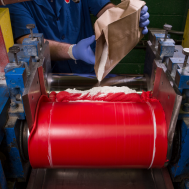Before we dig into this post, let’s define what we mean when we discuss elastomers.
The Polymer Science Learning Center provides a nice breakdown:
Elastomer is a big fancy word, and all it means is “rubber.” Some polymers which are elastomers include polyisoprene or natural rubber, polybutadiene, polyisobutylene, and polyurethanes. What makes elastomers special is the fact that they bounce. But just saying “they bounce” is kind of vague. Let’s be more specific. What makes elastomers special is that they can be stretched to many times their original length, and can bounce back into their original shape without permanent deformation.
When it comes to molding elastomers, the Apple Rubber team shows a nice ability to stretch, as well.
With several different applications — including FKM, NBR, EPDM, silicone and more — we have the ability to mold several different variations of rubber, polymers and elastomers.
“If we find that a current standard compound doesn’t work,” Materials Manager John Tranquilli notes, “we can quickly modify or develop a new, specific compound to meet our customers’ needs.”
Different clients, different needs: custom elastomers
Customer requirements are rarely the same. If a client needs custom elastomeric material, our polymer chemists get to work.
Here are some examples of situations that can require unique elastomers:
Electrical housings and weather seals: In this application, materials are subject to ozone attack. To offset the harmful effects of ozone, Apple Rubber creates packages to prevent free radicals from destroying the polymer.
Propane industry: During developmental stage, hexane is used to test products as a substitute for propane. Underwriters Laboratory (UL) uses this process as part of their qualification testing.
Hexane will extract many of the plasticizers used in rubber compounds. When parts are exposed and then allowed to dry out, a significant shrinkage in dimensions for a seal will result — and this can cause compression loss or possible seal failure.
To offset this possibility, we redevelop a compound using a plasticizer more resistant to hexane extraction.
“Friction is also a common problem here,” Tranquilli adds. “By varying different additives, we can create a compound to help the part be smooth and slippery.”
Marketing needs and color compounds: Some customers will have aesthetic requirements for specific products. We develop color compounds, as long as the temperature changes in the molding process are precisely monitored — color can change with the heat from moldings or post cure.
“The challenge here is that color is affected by the change in temperature,” says Tranquilli. “We have to get the mixture just right to accept the color, and then make sure it stays consistent through the cure cycle.”
Understanding the importance of fluorine levels
FKMs are based on their percentage of fluorine. A standard polymer may be 67 percent fluorine, but customers sometimes need additional fuel, oil or chemical resistance.
We can develop a polymer that has roughly 70 percent fluorine, offering an increased resistance to harsh or caustic substances.
“Because we are not fixed on one polymer and can handle a large range of parts, customers may be able to reduce the number of vendors they use,” Tranquilli says. “That can save time and money, and they don’t have to certify as many vendors.”
Always getting better
In addition to developing polymers, our chemists spend just as much time improving existing designs.
“It’s important to suggest a better product to extend the application’s existence,” Tranquilli says. “We look at how the application is being used — and what environmental factors it’s exposed to — and develop a plan. Frequently, a simple change of the polymer will lengthen product life for our customer.”
